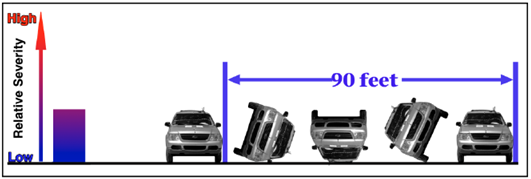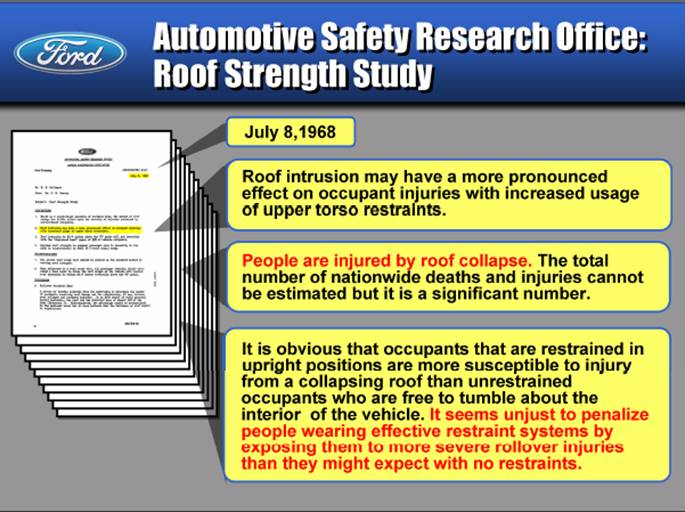An SUV rolled over near Salt Lake City on March 20, causing severe injuries to the driver. The Utah Highway Patrol reports that the man was trying to exit Interstate 80 when his vehicle lost control. After his SUV flipped over, the driver required helicopter transportation to a local hospital, where he remained in critical condition on Friday.
Every year, the number of people killed in rollovers increases. While rollovers represent a small (but rising) number of total crashes, they are the biggest killers in light trucks and SUVs—a true epidemic. But rollovers only become truly dangerous when design defects in the vehicle—for instance, weak roofs or ineffective restraints—place the occupant at risk.
Rollovers Are Survivable with Proper Vehicle Design
The forces generated by most SUV rollovers are well within human tolerance if the roof does not crush significantly into the occupant compartment and the vehicle otherwise protects the occupant. Thus, vehicle design is often a key safety factor in protecting rollover victims.
Most rollover accidents are relatively less severe and less violent as compared to other accident modes. In a frontal collision with a fixed object at 30 mph, all of the energy of a vehicle moving at 30 mph is lost in a fraction of a second and only a few feet of travel. That is a very severe event.

In contrast, when a vehicle rolls over while traveling at 30 mph, the energy is dissipated over a longer period of time and a larger distance—making a rollover relatively less severe than a frontal, side or rear impact at that speed.

But rollovers become much more dangerous when there is excessive roof crush caused by structural deficiencies, defects in restraint systems and/or a loss of occupant containment.
“Roof Crush” Is Often Fatal in Rollovers
In order to properly protect an occupant in a rollover, the roof structure needs to be strong enough to resist deformation of the roof into the “non-intrusion” zone around the occupants.
The relationship between rollovers and harm to occupants from roof crush has long been known, as shown by a 1968 study from Ford’s Automotive Safety Research Office:

The auto industry saved billions of dollars making cars with weak roofs for four decades. Although the theory has now been rejected by National Highway Transportation Safety Authority and others, automakers continue to peddle it as a excuse for the tens of thousands of needless deaths and spinal cord injuries that weak roofs have caused.
Seat Belt Failures Contribute to Rollover Injuries
Unfortunately, many seat belts fail to properly lock and stay locked during rollovers, allowing seat belt webbing to spool out and expose occupants to injury. This fact was reported by a seat belt vendor, TRW, in a 1996 memo to Ford.
Designs of belt restraint that minimize movement include restraint systems with friction-lock latch plates, integrated seat/belt systems, torso web-locks and rollover-activated pre-tensioning devices.
Lack of Advanced Window Glazing Increases Ejection Rates
Many serious injuries in rollovers result from ejection or partial ejection. The tempered glass in the side windows of most cars, light trucks, sport utility vehicles, and vans shatter into many small fragments during a rollover. Once the glass shatters, there is a huge hole in the side of the vehicle through which people can be partially or totally ejected.
Ejection injuries should be minimized through the use of laminated glass. For many decades, laminated glass has been required in windshields of cars that are sold in the United States.
Laminated glass consists of two pieces of glass bonded together with a tic inter-layer, typically consisting of polyvinyl butryal (PVB). In a rollover, the glass will fracture but the inner layer holds the glass in place, which contains occupants by preventing ejection. Side windows are “the most significant glazing ejection route.”
According to one reject NHTSA report, up to 1,300 lives per year could be saved by advanced side glazing.
Door Failures Lead to Ejection in Rollover Crashes
A door that opens during a crash exposes the vehicle’s occupants to an elevated risk of full or partial ejection. Because door systems frequently do not perform well during a crash, ejection is still one of the biggest hazards for vehicle occupants.
Typical doors can fail in various ways, such as defects in linkage, handle or inertial actuation. Moreover, other kinds of doors used in vehicles likewise experience failures. For example, sliding door assemblies in minivans have experienced failures due to poor quality materials used in some of their components. Hatchbacks and lift gates on utility vehicles are sometimes made from a composite material called sheet-molding compound, which can vary significantly in strength between batches (thus offering no real consistency in performance) and which offers no energy absorption once it has shattered.
Lack of Rollover-Activated Side Curtain Air Bags
Studies have shown that side curtain air bags that protect an occupant’s head reduce the number of fatalities by 45 percent, and side curtain air bags have been found to reduce ejections from vehicles. Side curtain air bags also have been found to reduce head injuries in crashes.
Air bag defects can be grouped into two general categories—failure to deploy and failure to install.
A side curtain air bag may fail to deploy for two primary reasons. First, the sensors may fail to trigger deployment. For example, auto manufacturers may place the sensor in the B-pillar of the vehicle. In a side-impact crash, the air bag will deploy because forces are exerted on that pillar. But in a narrow overlay offset impact, the air bag may not deploy because the sensor in the B-pillar did not experience any forces or because of a manufacturing defect or poor design.
The second type of defect is the failure to install side curtain air bags at all. Some auto manufacturers seek to make a profit by offering this lifesaving technology as a safety option, rather than a standard feature, so many vehicles are sold without side curtain air bags.
Committed to Helping Victims of SUV Rollover Crashes
As shown in this recent and tragic Utah crash, rollovers can happen without warning—especially for the drivers of SUVs. If you or a loved one have been injured rollover accident, contact our auto defect attorneys at The Ammons Law Firm for a free, confidential consultation. We’ve recovered over a billion dollars on behalf of injured consumers and drivers throughout Texas and beyond. With compassion, dedication, and experience, we aim to help those impacted by critical auto design defects and hold vehicle manufacturers accountable for failing to protect them.
Disclaimer: On our blog, we report on recent catastrophic accidents to begin important conversations about consumer safety. Our hearts go out to all the victims mentioned in this article, and we sincerely hope that future injuries and deaths can be prevented. If these resources are found to include any false or outdated information, we invite you to contact The Ammons Law Firm as soon as possible so we may update them. This content should not be construed as legal counsel or advice.





